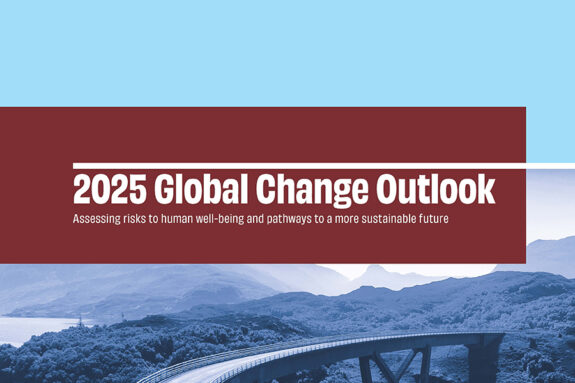MIT panel discussion explores best practices
Read this at MIT Joint Program on the Science and Policy of Global Change
The Covid-19 pandemic could be a dry run for future impacts of climate change, with challenging and unprecedented situations requiring rapid and aggressive responses worldwide. A proactive approach to climate change aimed at minimizing such impacts will inevitably involve significant cuts in greenhouse gas (GHG) emissions and investment in more resilient infrastructure. Although current global mitigation and adaptation efforts are proceeding slowly, one emerging strategy could serve as an accelerant: the financial disclosure of climate risk by companies. Such disclosure, if practiced more widely and consistently, could lower the risks of climate change by redirecting investments away from GHG-emitting activities and pinpointing infrastructure that needs to be made more resilient.
Toward that end, the MIT Joint Program on the Science and Policy of Global Change engaged dozens of decision-makers in the financial sector and industry in a two-hour panel discussion on climate-related financial risk. Held as a Zoom meeting on March 26 and facilitated by Joint Program Co-Director and EAPS professor Ronald Prinn, the discussion featured six finance and economics experts from the Bank of England, the Bank of Canada, HSBC, BP and MIT. Panelists described how their organization has been affected by climate-related financial risk and the steps it’s taking to address it, how climate and economic scenarios could be useful in better understanding climate-related financial risks, and potential research that an institution like MIT could pursue to advance the state of knowledge in this area.
Organizational impacts and responses
Physical risks—potential losses due to more frequent and severe weather driven by climate change—and transition risks—potential losses due to a rapid transition to a low-carbon economy—pose significant economic threats to financial institutions and industrial firms. Those represented on the panel have taken notice and are mounting systemic responses.
Theresa Löber, Head of the Bank of England’s Climate Hub, noted that the Bank has taken a lead role in ensuring that financial firms develop an enhanced approach to managing the financial risks of climate change. Each institution under its control is required to appoint a senior representative who’s accountable to the Bank, incorporate physical and transition risk into its existing risk management framework, perform scenario analyses, and properly disclose climate risks. The largest firms must also undergo a climate stress test.
A climate focus is also prominent at the Bank of Canada, as part of its mandate to promote economic stability. The Bank participates in a network of central banks focused on greening the financial system through an exchange of ideas on how best to assess climate-related risk, and conducts its own studies of different climate and economic scenarios.
“Generally what we’re finding is that there’s a tradeoff between physical and transition risks depending on the pathway you look at,” said Craig Johnston, Senior Economist at the Bank of Canada. “If we do nothing [to reduce emissions], we see very limited transition risks but the highest level of physical risks. On the other side of things, a rapid transformation toward a low- carbon economy has the highest transition risks, but it does mitigate physical risks to some degree.”
Guided by the actions of central banks and evolving market forces, private banks and firms in other sectors are taking climate-related financial disclosure seriously.
Alan Smith, Global Head of Risk Strategy at HSBC, observed that every kind of risk the financial institution faces is affected by climate change, so that the issue now informs all of the company’s activities.
Spencer Dale, Group Chief Economist at BP, observed that as a major oil and gas company facing a global energy transition to low-carbon sources, BP sees the issue of financial disclosure of climate risk as having less to do with the firm’s financial risks and more to do with its core purpose and structure. A key consideration is how products sold by BP can be consistent with a companywide goal of achieving net zero emissions by 2050. While carbon offsets, carbon capture technology and tree planting could be part of the solution, the company’s main challenge will be to shift the business to zero-carbon products.
Best practices for using scenarios in climate-related financial risk assessment
All six panelists saw an important role for scenarios—projections of how the climate and economy are likely to evolve under different climate policies and rates of energy technology market penetration—in enabling financial institutions and businesses to assess climate-related financial risk. There was general agreement that scenarios should not be seen as predictions, but instead as a range of plausible potential outcomes with varying levels of uncertainty.
Recognizing the inherent uncertainty of any single scenario, Dale noted that BP has surveyed the hundreds of scenarios in the Intergovernmental Panel on Climate Change (IPCC) database to help understand the range of possibilities for different new technologies and energy sources to contribute to a net zero emissions solution. On the other hand, Löber observed that the financial community was having difficulty sorting through the many scenarios now available, leading the Bank to limit its stress test to three reference scenarios representing a wide range of potential climate policy action.
“What we’re trying to test here is a combination of physical and transition risks across these different scenarios,” said Löber. “We’re trying to be as prescriptive as we can be so financial firms can process this, but also so that we can aggregate the results to understand how the system as a whole is exposed to these risks.”
Panelists differed on the utility of different kinds of scenarios. Some maintained that finer detail in the types of quantities projected in a scenario would help make it more relevant; others expressed concern about the challenges of making robust projections at that level of detail. Another concern was that models generating scenarios failed to account for potential tipping points—climatic or economic disruptions—that could dramatically alter projections. Finally, various participants highlighted the challenge of reconciling long-range climate and economic scenarios with shorter-term company-level concerns.
New research directions for MIT and beyond
Panelists and participants alike encouraged more research on climate-related financial disclosure at MIT and similar institutions, including ongoing upgrades of publicly available climate and economic models developed by the Joint Program.
Henry Jacoby, Founding Co-Director (Emeritus) of the MIT Joint Program and William F. Pounds Professor of Management (Emeritus) at the MIT Sloan School of Management, noted that a workshop in 2018 convened by MIT Vice President for Research Maria Zuber yielded a report and two broad directions for research. One was to simply use MIT’s existing models and develop a richer set of scenarios more targeted to the financial risk and disclosure problem. The other was to enrich these models with variables and sectors more relevant to the concerns of the finance community.
To produce relevant results, John Parsons, Senior Lecturer in Risk Management and Corporate Finance at the MIT Sloan School of Management, recommended that MIT complement its existing global economic modeling with parallel research into the more detailed microeconomic analysis that is needed to calculate financial exposure. The idea, he said, was not necessarily to put everything into a single model, but rather to focus on aspects of each scenario that relate to the financial risks to which individual companies are exposed.
BP’s Spencer Dale suggested an alternative emphasis for future research. “For us, the most valuable thing that MIT and others can do is not to produce more and more precise, specific, prescriptive scenarios,” he said, “but rather to help us better understand the range of uncertainty and confidence levels associated with existing scenarios.”
The discussion came to a close with two main questions: How might the Joint Program structure a research program at MIT so that it could continue to work closely with decision-makers who would ultimately use these scenarios, and how would such a program be funded? In the coming months, John Reilly, Co-Director of the Joint Program and a senior lecturer at the Sloan School, committed the Program to help coordinate an effort among MIT, finance and industry experts to address these questions and develop a detailed action plan.
Story Image Credit: Flickr/klem@s



